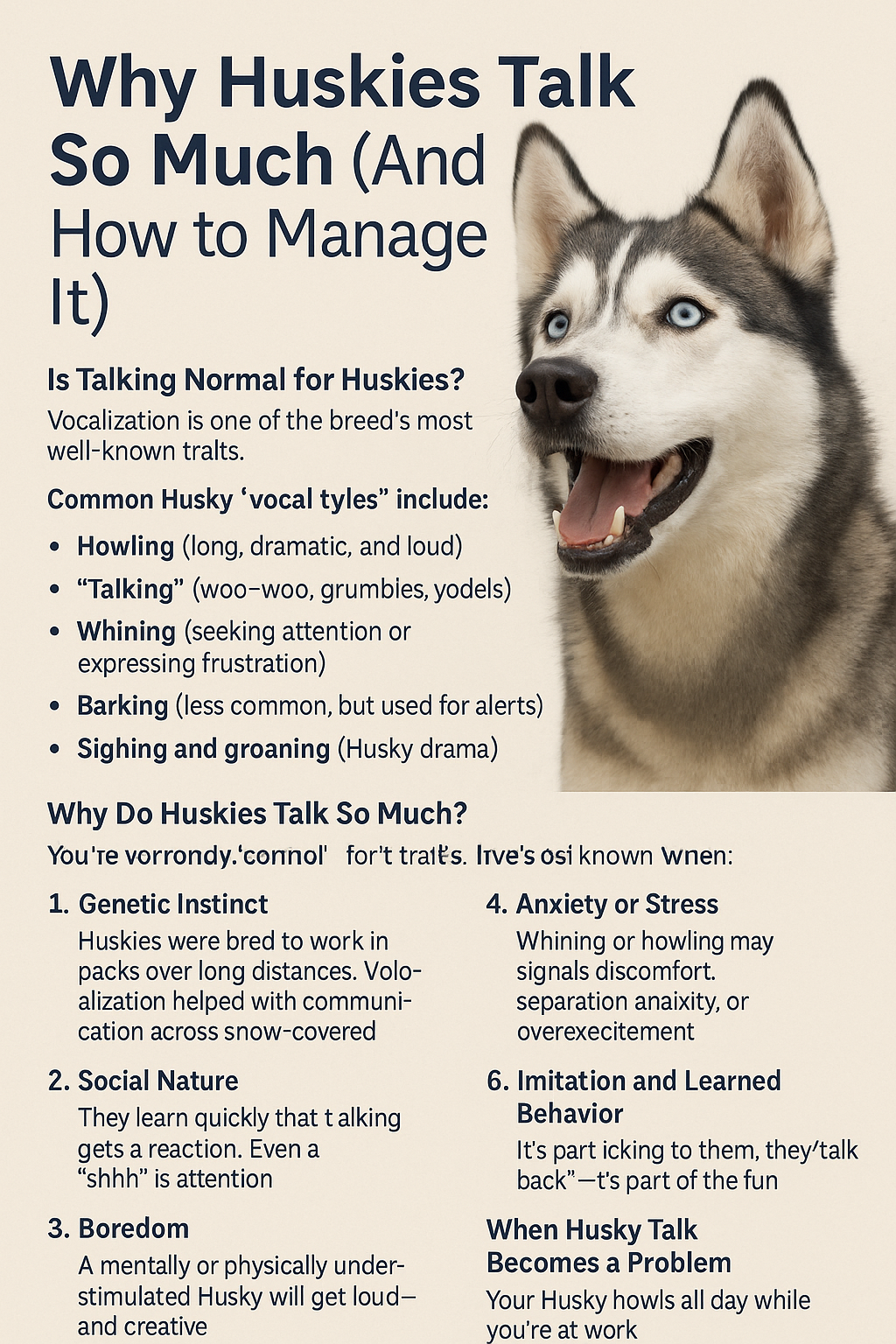If you’ve spent some time around a Husky, you’ve probly already heard their famous “woo-woo” the dramatics howls sighs yodels an’ those full-on arguments with the owners. Huskies aren’t only vocal—they’re performers, right? But, like, what’s behind the all the noise, huh? And more importantly how’d you manage it when it goes overboard?
Lets uncover why Huskies are so talkative, eh? an’ how to work with their voice– not go against it.
Is Chattin’ Normal for Huskies?
Yep! In fact vocalizin’ is among the breed’s most popular traits. It isn’t barking — they possess an entire sound language.
Common Husky “vocal stylings” contains
Howling, you know, long, dramatic, an’ loud
“Talking” like “woo-woo,” grumbles yodels
Whining seeking attention an’ frustrashun
Barking it’s less common but used for alerts
Sighing and groaning Husky drama
They are NOT doing this to be annoying– they are communicating reactin’ an’ expressin’ emotion.
Why do Huskies chat so much?
- Genetic Instinct
Huskies are bred to toil in packs throughout lengthy distances. Vocalization helped wit’ communication cross snowy landscapes.
2.
Social nature
They form intense bonds with their humans, craving interaction. Vocalization is a form of communication you see.
- Seeking attention
They swiftly figure out that chatting gets responses. Even a “shhh” is getting attention after all.
- Boredom
A husky not stimulated mentally or physically will get loud and be creative.
- Anxiety or stress
Whining or howling might point towards distress, separation anxiety, or perhaps overexcitement.
- Imitation, learned actions
If you talk to them a lot, they will “talk” back ya know. That is part of fun thing.
When Husky Talk Turns Troublesome
While little “woo-woo” is ok (and hilarious), there is a issue when this happens
Your Husky howls all day while you at work
Neighbors are complaining
They interrrupt training or meals with continual talking
They bark or whine to get what they desire
Vocalization connects to anxiety or even frustration.
Then it is time to establish rules.
Step 1: Identify the trigger.
Before controlling vocal conduct, find out what brings it about.
Ask:
Are they sleepy or bored at all?
Are they asking something (walk, food, attention)?
Is it because of someone or something outside?
Are they anxious or overstimulated?
Do they do it at specific times?
Track patterns, knowing the cause supports you in coming up with a answer
Step 2 Don’t reward unwanted talk
Should your Husky bark or howl for attention and you give it to um you are teachin’ ’em to make more noise next time
Here’s what you could do
Awaite silence before offering attention
Use a “quiet” cue with calm rewards
Walk away or turn away if they’re being loud in wrong ways
Give praise an treats for calm acting
Just ignore the noise reward the quiet
Step 3 Train a “Quiet” Command
Listen it’s possible to train your Husky to be quiet—but it need consistent effort
First off you wait for ’em to start their howl or barking
Say “Speak! ” and give em a treat
Next say “Quiet” then wait a bit
Give immediate rewards for being quiet
Short practice everyday
Pro tip Using a hand signal is great for better results
Step 4 Boost physical and mental workout
A tired Husky will be quiet Husky
Make sure of this
Do give sixty to ninety minutes of physical work each day
Get Mental enrichment like puzzles training or sniffing games
Also playtime with other dogs
Vocal Huskies will likely need some other activities Step 5: Handling Noise When You’re Out, Eh?
Dealing wit’ howling when absent:
Employ a white noise machine or soothing music.
Offer a KONG stuffed or a treat puzzle before departures, got it?
Use a pet camera to spy and dispense goodies, cool.
Skip them emotional goodbyes and hellos.
When needed, employ a dog walker or doggy daycare – yup, break up their day.
Step 6: Kinda, Sorta Accept the Sass
Husky vocalizations? That’s their thing, ya know? Can’t totally get rid of it, nor should ya!
So:
Set rules on when and where sass is allowed.
Laugh at it if it’s just playful banter, hehe.
Use that sass, that energy, for deeper bond.
But listen, what’s funny at 10 AM could be annoying at 3 AM, so be smart ’bout the training!
Final Notes: Find That Harmony – Okay?
Huskies aren’t drama queens for no good reason. Trying to bond, talk, and have some laughs. With the right structure, training and, stimulating activities? You can tone down the annoying chatter – and keep the cute stuff.
Because understanding your Husky’s “voice” helps forge a different bond, like no other dog breed.
Let them chatter away–but school them in the art of appropriate timing and the right way.
